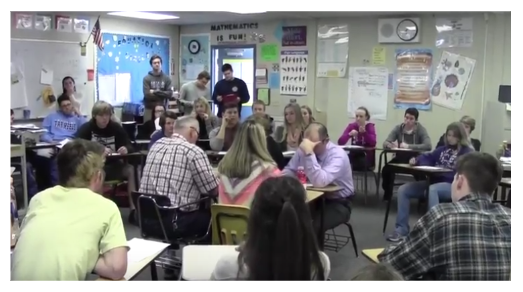Jeanne Villeneuve, Loomis, CA
Last year I invited four teachers into my room to solve The Locker Problem in front of my senior math class. The students chose this problem because they found it especially challenging, and wanted to see how a group of non-math teachers would make sense of this problem. I think some delighted just a bit in the idea of watching their teachers squirm. Upon entering the room, the Spanish teacher, Mrs. McKinney, grabbed a box of Kleenex and pronounced to the students, who were seated in a large circle around the teacher group, that math had made her cry all through high school.

After another member of the team read the problem, Mrs. McKinney joked that they should go to the hallway to act out the problem, and then quickly added “Could we use less lockers though?” The students exchanged surprised and impressed glances…she had figured out something it took them quite a while to do. Imagine her surprise when I told her she was on to something. What proceeded was an experience that was quite informative to my students, myself, and the participating teachers. Students witnessed strategizing, persistence, frustration, aha moments, and some excellent and not so excellent teamwork. During the debriefing I mentioned my concern that I did not know if Mrs. Smith, an English teacher, was following for a very long time, because she was so quiet. To this, Mr. Zimmerman, a Science teacher who had been pushed farther out of his comfort zone than he had anticipated, exclaimed “Oh my gosh, I hadn’t even noticed.” Afterwards, this was the exchange that had made the biggest impact on my students: The realization that they both needed to speak up when they were confused, and also be much more cognizant of whether the rest of their group members were following along. During the debriefing I also had each teacher graph their confidence level throughout the process and discuss their graphs. The biggest takeaway for me was witnessing the dialogue of my colleagues, which sounded much more similar to that of my students, than that which I experience with my math colleagues when we are solving problems at a workshop.
Everyone agreed that this was a worthwhile experience and my students encouraged me to continue to do this with future classes. This year I invited my colleagues to participate, and was able to get two groups of four faculty for my two senior math periods. One of those classes includes students from another campus who participate in distance learning via cameras and a television. These students are part of a group with students who are in my classroom. It seemed only natural, then to include a teacher from their campus who worked together with teachers from my campus to solve a problem written by Tom Sallee; the problem involved recognizing Fibonacci’s pattern to reach the solution. English teacher, Joel Agee, quickly discerned that this problem involved the use of permutations. Students raised their eyebrows and began writing this on their observation sheets, while some called me over to ask me what that was. On their observation sheets students were required to record strategies, comments and questions. Prior to the problem, I had given my students control over the process, instructing them that it would be up to them to decide when and how to intervene if the group got stuck, or headed down a wrong path. The next day Mr. Agee sent me an email saying “As fun as it was, what sticks with me is the feeling I know our students have regularly: getting stuck. With everybody watching you…They’re the experts in coping with it; it validates their struggle to see teachers share it, and it gives them occasion to use their past success to provide genuine help.”
Colleague Joe Hancock, who solved The Pizza Problem with another group commented “We approached (the problem) from several different angles and while the math we needed to learn was in many ways just out of reach, with very little teaching, we arrived at the answer to the problem.”
My students found this experience both fun and informative. Next week a group of them are looking forward to being a part of their own fishbowl as they demonstrate effective math discourse for my Integrated 2 class.
